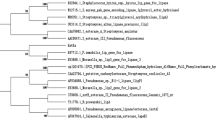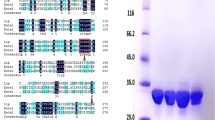Abstract
Bacillus stearothermophilus esterase contains two free cysteine residues at positions of 45 and 115, which react with sulfhydryl reagents resulting in a significant decrease in the enzymatic activity. To understand the role of the cysteine residues in catalytic regions of the esterase, the residues were replaced with serine or alanine by site-directed mutagenesis to construct four single-mutated enzymes (C45A, C45S, C115A, C115S) and two double-mutated ones (C45/115A and C45/115S). Wild-type and mutant enzymes were produced in Escherichia coli cells and purified to homogeneity to examine their chemical and kinetic properties. These mutant enzymes had esterase activity, which suggested that none of the cysteines were required for its activity. Moreover, replacement of both two-cysteine residues made the enzyme insensitive to p-chloromercuribenzoic acid and extensively stabilized it at high temperatures of around 70°C. These results demonstrate that replacement of free cysteine residues by site-directed mutagenesis can improve the thermostability of thermophilic enzymes.
Similar content being viewed by others
References
Amaki Y, Tulin EE, Ueda S, Ohmiya K, Yamane T (1992) Purification and properties of a thermostable esterase of Bacillus stearothermophilus produced by recombinant Bacillus brevis. Biosci Biotechnol Biochem 56:238–241
Brady L, Brzozowski AM, Derewenda ZS, Dodson E, Dodson G, Tolley S, Turkenburg JP, Christiansen L, Huge-Jensen B, Norskov L, Tim L, Menge U (1990) A serine protease triad forms the catalytic center of a triacylglycerol lipase. Nature 343:767–770
Chung GH, Lee YP, Jeohn GH, Yoo OJ, Rhee JS (1991) Cloning and nucleotide sequence of thermostable lipase gene from Pseudomonas fluorescens SIK W1. Agric Biol Chem 55:2359–2365
Krisch K (1971) Carboxylic ester hydrolases. In: Boyer PD (ed) The enzymes. Academic Press, London, p 43
Kugimiya W (1988) Structure, Expression and Site-directed Mutagenesis of Bacterial and Fungal Lipase Genes (in Japanese). Ph.D. thesis, Kyushu University, Fukuoka, Japan
Kunkel TA, Roberts JD, Zakour RA (1987) Rapid and efficient site-specific mutagenesis without phenotypic selection. Methods Enzymol:367–382
Matsunaga A, Koyama N, Nosoh Y (1974) Purification and properties of esterase from Bacillus stearothermophilus. Arch Biochem Biophys 160:504–513
McRee DE, Redford SM, Getzoff ED, Lepock JR, Hallewell RA, Tainer JA (1990) Changes in crystallographic structure and thermostability of a Cu, Zn superoxide dismutase mutant resulting from the removal of a buried cysteine. J Biol Chem 265:14234–14241
Meghji K, Ward OP, Arujo A (1990) Production, purification, and properties of extracellular carboxyl esterase from Bacillus subtilis NRRL 365. Appl Environ Microbiol 56:3735–3740
Nakagawa A, Tsujita T, Okuda H (1984) Purification and some properties of intracellular esterase from Pseudomonas fluorescens. J Biochem 95:1047–1054
Okumura S, Iwai M, Tsujisaka Y (1983) Properties and substrate specificities of four esterases from Aspergillus niger NRRL 337. Agric Biol Chem 47:1869–1872
Omar IC, Hayashi M, Nagai S (1987) Purification and some properties of a thermostable lipase from Humicola lanuginosa no. 3. Agric Biol Chem 51:37–45
Sugihara A, Tani T, Tominaga Y (1991) Purification and characterization of a novel thermostable lipase from Bacillus sp. J Biochem 109:211–216
Sugihara A, Ueshima M, Shimada Y, Tsunasawa S, Tominaga Y (1992) Purification and characterization of a novel thermostable lipase from Pseudomonas cepacia. J Biochem 112:598–603
Tsujita T, Ninomiya H, Okuda H (1989) p-Nitrophenyl butyrate hydrolyzing activity of hormone-sensitive lipase from bovine adipose tissue. J Lipid Res 30:997–1004
Tulin EE, Amaki Y, Nagasawa T, Yamane T (1993) A Bacillus stearothermophilus esterase produced by a recombinant Bacillus brevis stabilized by sulfhydryl compounds. Biosci Biotechnol Biochem 57:856–857
Volkin DB, Klibanov AM (1987) Thermal destruction process in proteins involving cysteine residues. J Biol Chem 262:2945–2950
Author information
Authors and Affiliations
Additional information
Correspondence to: T. Yamane
Rights and permissions
About this article
Cite this article
Amaki, Y., Nakano, H. & Yamane, T. Role of cysteine residues in esterase from Bacillus stearothermophilus and increasing its thermostability by the replacement of cysteines. Appl Microbiol Biotechnol 40, 664–668 (1994). https://doi.org/10.1007/BF00173326
Received:
Revised:
Accepted:
Issue Date:
DOI: https://doi.org/10.1007/BF00173326




